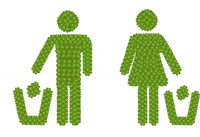 If you are a woman suffering from urinary incontinence, here are three things you should know:
If you are a woman suffering from urinary incontinence, here are three things you should know:
- Only about 50% of women with urinary incontinence ever seek help
- Embarrassment is one of the primary reasons preventing these women from asking for help
- According to the Agency of Healthcare Research and Policy, urinary incontinence can be improved in 8 out of 10 cases
Does this sound crazy to you?
Why Urinary Incontinence is Embarrassing
Despite the fact that urinary incontinence affects more people than conditions like diabetes or Alzheimer’s, half of all women with urinary incontinence won’t seek help. Those who do seek help wait, on average, almost seven years. Why?
In a recent seminar co-sponsored by the National Association for Continence, experts discussed how cultural taboos prevent people from talking about this topic. These experts explained how shame is associated with bathroom issues from an early age, during the potty-training stage. Young children are taught that they are either “good girls” or “bad girls,” depending on whether they “performed” well in potty training.
Years later, the same “good girl” and “bad girl” language subconsciously haunts women, and keeps them from discussing their problems of urinary incontinence with healthcare providers.
How to Overcome the Embarrassment
While discussing urinary incontinence is embarrassing for many women, there are ways to overcome that emotion. After all, most of us have learned to overcome embarrassment about other situations in our life, why not about urinary incontinence? If you are ready to get over your embarrassment and get help, here are two simple steps you can take:
Discuss Your Situation with the Right Person
Chat with a close woman friend who has had urinary incontinence and sought help. Not only will she understand and sympathize with your situation, but she will be able to offer you guidance and advice based on her own experiences. You need not feel embarrassed talking to someone who has had the same experiences as you.
Learn More About Your Condition
Knowledge is power. Learning more about urinary incontinence gives you the knowledge and power you need to ask for help from a healthcare provider. Learn more about the different kinds of urinary incontinence and the available treatment options. Knowledge about your condition helps you understand that there are solutions available, and gives you the words you need to comfortably discuss your condition with your doctor.
People say that it’s never too late to have a happy childhood. We say that it’s never too early to seek help for your urinary incontinence. The earlier you address your condition, the faster you will see positive results with the right treatment. Commit to taking a step toward drier panties today, whether it be talking to someone about your condition or learning more about urinary incontinence online.
If you enjoyed this post, we invite you to check out our book, leave a comment, contact us, download our free ebook, or interact with us on Twitter and Facebook.
Image courtesy of Stuart Miles / FreeDigitalPhotos.net









